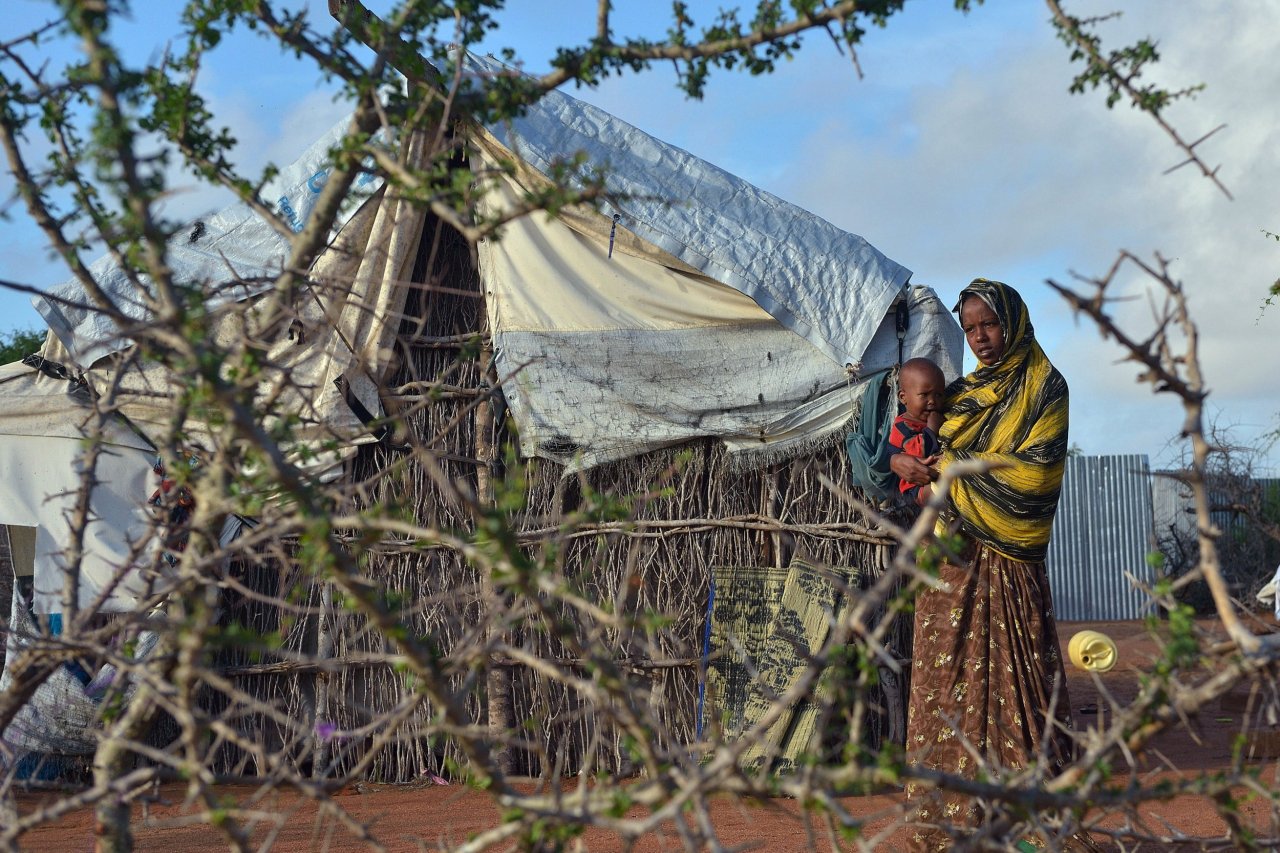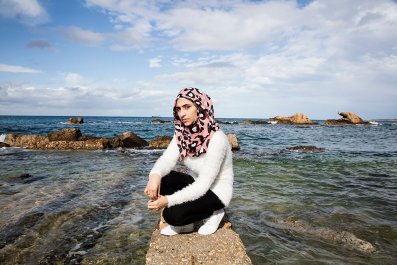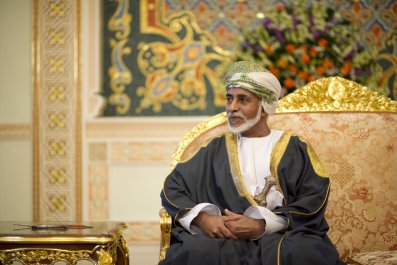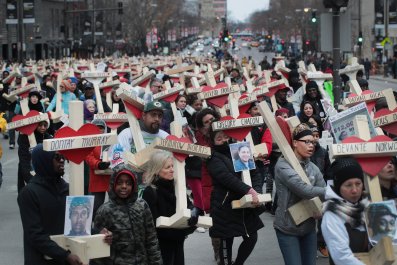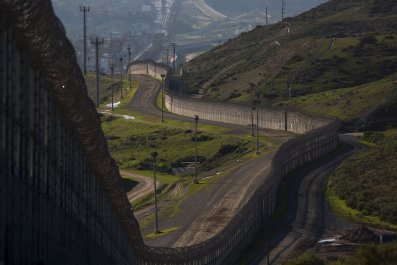After decades scraping by in dusty refugee camps in Kenya, Muhumed Mohamed Abdi was finally on his way out. He had fled the fighting that erupted in Mogadishu, the capital of Somalia, after rival militias overthrew the government in 1991. After more than two decades of waiting in refugee camps, he and his family of four had secured seats on a flight due to leave Nairobi for Missouri on January 30; the U.S. had accepted them under the U.S. refugee resettlement program. The 38-year-old had sold off everything he owned in Dadaab, the sprawling camp complex where hundreds of thousands of Somali refugees have lived since the early 1990s, and arrived in Nairobi, ready to start a new life.
But on January 29, the day before his flight, Abdi learned that he and his family weren't going to America after all. A couple of days later, they were told they would be going back to Dadaab. "Today, we were informed officially that we are going back to our camps due to this travel ban of Donald Trump," says Abdi, speaking from a transit center where dozens of refugees were stranded. "It's a disaster."
Abdi and his family are among the tens of thousands of people around the world whose futures have been thrown into disarray by President Trump's January 27 executive order that put the U.S. refugee program on hold for 120 days; indefinitely barred Syrian refugees from entering the U.S.; suspended individuals from seven Muslim-majority nations, including Somalia, from entering the country for 90 days; and slashed the number of refugees to be resettled in the United States this year from 110,000 to 50,000. The policy, which is short on details on how to implement such sweeping changes, ignited protests at airports around the world and caused widespread confusion. Refugees are still awaiting further rulings from America's courts.
On February 3, a federal judge in Seattle issued a ruling that temporarily blocked Trump's order, prompting a rush by visa holders and refugees to get to the United States. The U.N migration agency, International Organization for Migration (IOM), says the U.S. State Department has since given guidance that refugees who were on their way to the U.S. before Trump's order will be able to enter until February 17. It is not clear how many will actually be able to come: Of the approximately 19,000 refugees whose plane tickets were cancelled after the order, IOM is hoping between 1,800 and 2,000 people will be able to enter the U.S. in the next two weeks. Nor is it clear whether this will include Abdi, or others from camps like Dadaab. Abdi could not be reached by phone. "They've now left and are back in the camps" says Leonard Doyle, an IOM spokesperson in Geneva. "We are urgently trying to get them lined up so they can take advantage of this window."
Read more: An Iraqi-American lawyer details her detention at the U.S. border in Michigan
As individual refugees deal with the shock created by Trump's order, so too are host nations trying to figure out how to cope with the increased burden the decision will place on them. Right now, most of the world's 21.3 million refugees stay in Africa and the Middle East, while the six wealthiest countries host less than 9 percent of the world's refugees, according to Oxfam International. The U.S. has historically been generous, offering more permanent homes to refugees through its formal resettlement program than any other nation in recent years, including nearly 85,000 in the last fiscal year. If that changes, it could put even more strain on poor countries, which already struggle to find refugees new homes and could leave thousands stuck in limbo. Many are from places like Syria, Somalia and Afghanistan and have no immediate hope of returning home.
"If the mightiest country in the world is afraid of the most vulnerable, what example does that set for some of the poorest, which have taken the responsibility of hosting hundreds of thousands of refugees, in some cases for decades?" Joel Charny, the U.S. director of Norwegian Refugee Council (NRC), said in a January 30 statement.
One of those countries is Kenya, which has already made it clear it is tired of the job. Kenya has hosted hundreds of thousands of Somali refugees in Kenyan cities and the Dadaab and Kakuma refugee camps since militias ousted Somali dictator Mohamed Siad Barre in 1991, prompting a civil war and decades of lawlessness that allowed the violent militant group al-Shabaab to take control over parts of the country. Last May, after the European Union cracked down on migrants, the Kenyan government—sensing an ebbing sympathy for refugees internationally—announced its intention to shutter Dadaab. Kenya cited concerns that al-Shabaab was using the camp as a base to plan attacks but also noted that putting security ahead of refugees had become "standard practice worldwide," even in much wealthier countries. The government has since said the complex, which housed over 256,000 refugees as of January, will close this May.
The planned closure has prompted some Dadaab residents to return to Somalia, but an NRC survey found most residents don't want to go back to a place they still see as unstable. Al-Shabaab, though weakened, still poses a significant threat in Somalia; two days before Trump signed his order, the group killed 28 people in an attack at a hotel in Mogadishu. "You can see what is happening back in Somalia," says Ahmed Omar, a 43-year-old resident of Kakuma, who has been applying for U.S. resettlement for years with his wife and eight children. "No one is willing to go back."
As the camp's closure deadline looms, the office of the U.N. High Commissioner for Refugees, the U.N.'s refugee agency, says that the hundreds of thousands of refugees there will not be forced to return to their country, but it could not be more specific about where they might go. If the U.S. ban continues, that would be one less option for the refugees. "UNHCR is looking for other solutions for [refugees] and urging the Kenyan government to continue to meet its international obligations," says Yvonne Ndege, a UNHCR spokeswoman in Kenya.
Read more: David Miliband: Kenya refugee camps must be replaced with "something better"
Refugees like Abdi have an uncertain future. Depending on what the courts decide, Trump's order could mean that approved refugees will have to undergo extra security screening before being admitted to the United States. Approval for resettlement is already a grueling process that can take years; the UNHCR flags only the most vulnerable refugees in cities and camps like Dadaab and refers their cases to countries offering resettlement to refugees.
Governments then vet the cases for approval. "These are not just people who want to go to America," says Ndege. "They have been identified as having the strongest cases out of millions." People from Somalia are among the most carefully vetted nationalities in the world, she adds. Some of the 26,000 Somali refugees in Kenya who are in the U.S. resettlement "pipeline" have been in that process for more than a decade.
Omar is holding on to hope. He says people in Kakuma who have been approved for U.S. resettlement are angry and frustrated, and some have even been admitted to the camp hospital because of stress. It's a bleak scene, but he thinks the U.S. may still change course. Polling shows less than a third of Americans think Trump's move will make them safer. "When [Trump] was campaigning, he said several times that Somalis are very threatening to America. I don't know why," Omar says. "If Trump says all Somalis are terrorists, can we say all Americans are against refugees?" Omar knows neither statement is true.



